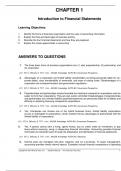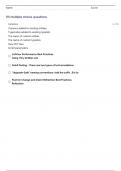Tentamen (uitwerkingen)
Solution Manual for Financial Accounting Tools For Business Decision Making 10th Edition Paul D. Kimmel, Jerry J. Weygandt, Jill E. Mitchell 2024 | All Chapters A+
- Vak
- Instelling
Copyright © John Wiley & Sons, Inc. Solutions Manual (For Instructor Use Only) 1 CHAPTER 1 Introduction to Financial Statements Learning Objectives 1. Identify the forms of business organization and the uses of accounting information. 2. Explain the three principal types of business activity....
[Meer zien]





